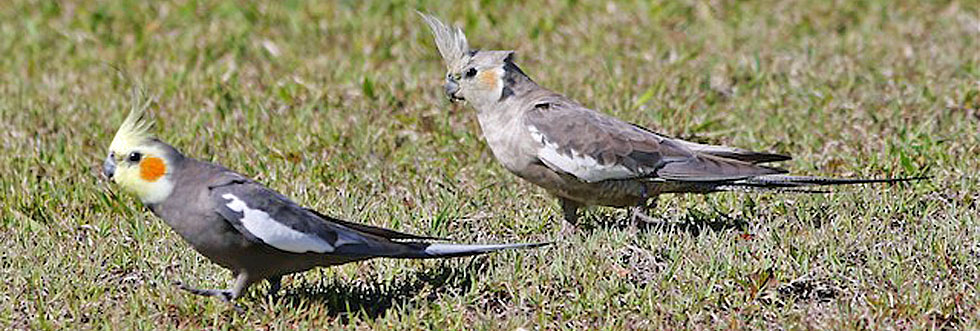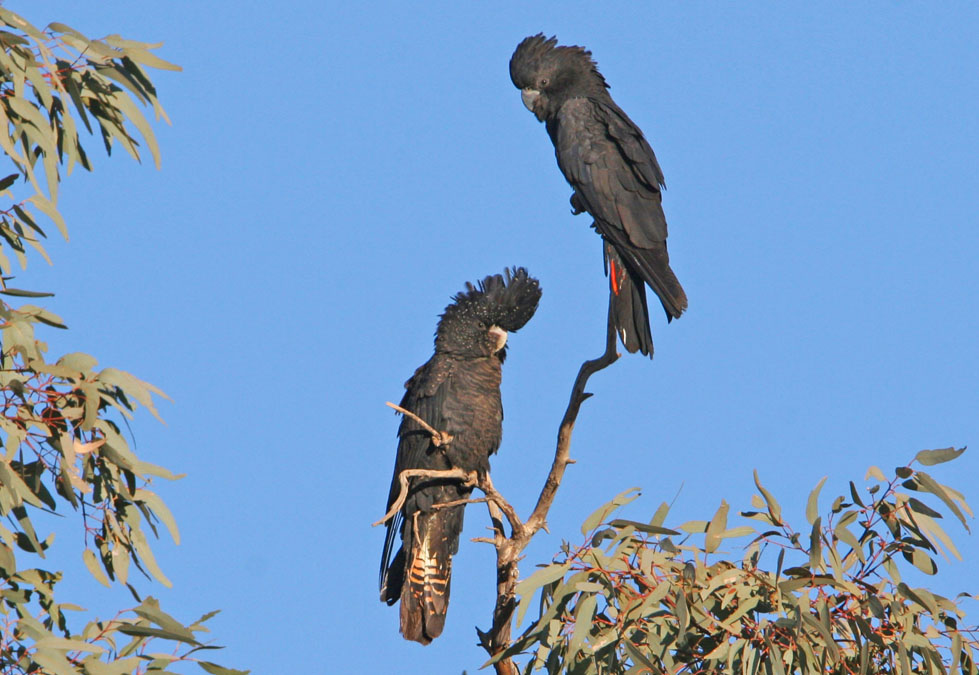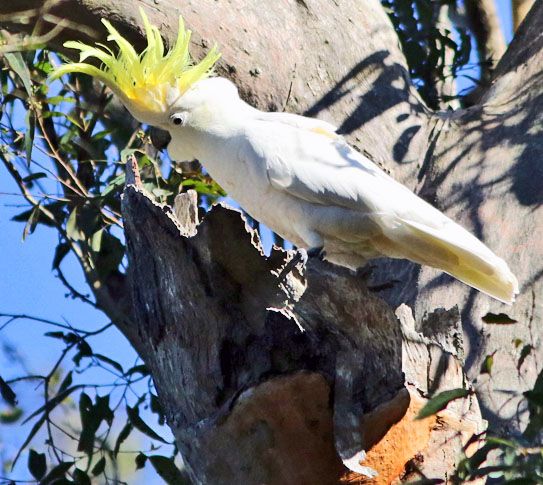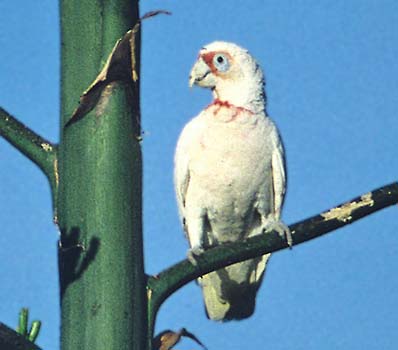
a web page by Don Roberson |
 |
||
COCKATOOS Cacatuidae |
||
|
||
Surely the most recognized large white cockatoo is Sulphur-crested Cockatoo (left) of east and north Australia and New Guinea, which also sports a prominent yellow crest. You can see that its crest is erectile: defensively or in courtship. Several large cockatoos have this ability, including White Cockatoo, which is sometimes called "Umbrella Cockatoo." The 8 species of big white cockatoos are striking birds of forest, eucalypt woods, or more open country, depending on species. As a visitor from the northern hemisphere, I was very impressed by my first view of such a big white bird in flight. The size and manner of flight strongly recalled Snowy Owl to me, and I've had that strange image ever since. |
||
While 12 of the cockatoos are white or mostly white (with crests of varying colors), seven are black, blackish, or gray: an example is Yellow-tailed Black-Cockatoo of southeast Australia (right, in a lovely shot by Hans & Judy Beste). The five species of black-cockatoo somewhat replace each other geographically, except in southwest Australia where two very similar species occur sympatrically, and survive because they differ in bill length and thus eat different seeds. These big dark birds are also very impressive in flight — here's two flight shots (below) of a flock of Baudin's Black-Cockatoo.
|
||
|
||
| The most widespread cockatoo in Australia is Galah (below), with its rosy face and underparts, white crown, and gray upperparts. It is a pink-and-gray cockatoo at a distance, but there a bird actually called Pink Cockatoo Lophochroa leadbeateri in Australia's arid interior. It is a mix of light pink and white, and wields a colorful crest (a prior name was "Major Mitchell's Cockatoo" — which I rather liked as it has a major-league crest). The Galah (below) was once a bird of the arid interior but, as it is well adapted to open country, has expanded its range with human settlement and agricultural development (Rowley 1997). Galah are sociable birds and can sometimes be found in flocks up to 1000 birds. | ||
 |
||
On my first trip to Australia with two friends, we took turns driving the rental car. My friend Steve was driving when I spotted what looked like a bunch of birds out in a field, so I suggested that we turn around and check them out. "Nah," said Steve, who had seen them from the corner of his eye, "it was just a field full of sheep." But I insisted that they were birds, so we went back — and found a flock of Little Corella Cacatua sanguinea. A flock of Long-billed Corella on the ground (below) can still give one that same image — and of course I now think "sheep" when I encounter such a flock. A final corella is endemic to Tanimbar Corella Cacatua goffiniana, scarce and declining on Tanimbar in the south Moluccas. Various introduced populations exist from Singapore to the Lesser Sundas. |
||
 |
||
 |
||
Cockatiel (above) is the smallest member of this family; it wanders erratically throughout the Australian interior. Among pairs of Cockatiel, males have the yellow head while females are mostly gray, but both show a rosy cheek patch. Like most parrots, cockatoos are monogamous and pair for life. Many Cockatiel are now bred in captivity, where it is among the most popular of all cage-birds. Seven cockatoos are found on islands between New Guinea and the Philippines; four of them are globally threatened (Birdlife International 2000). One of those is the beautiful Philippine (or Red-vented) Cockatoo Cacatua haematuropygia, a Philippine endemic that is now rare and local to a few of the southern islands. When I first visited the Philippines in 1990, our group saw a pair on the Palawan Island mainland, where a pair flew over us as we walked along a stream. I wrote: "This is a lovely white small cockatoo; a bit of yellow wash to the back of the head & bright salmon undertail coverts." When I returned to the Philippines 15 years later, this species was almost entirely gone from the main forest of Palawan, and there were no longer any predictable spots of occurrence. To see it, one took a boat to a tiny offshore islet, and watched a few fly in at dusk. Views were limited to white birds in flight a long distance away from a rocking dinghy. The experience is no longer the same. Let's hope that they'll make a comeback in the future. Most encounters with big cockatoos are memorable. I've certainly been impressed by the the big white ones and the big black ones. Palm Cockatoo Probosciger aterrimus of coastal forests from New Guinea to Cape York Peninsula, northeast Australia, has a truly massive bill, a long black crest, and bare red facial skin. In Australia, Red-tailed Black-Cockatoo inhabits forests in the north and shrublands in the southeast, but also wanders extensively in pair or family group. This pair of Red-tailed Black-Cockatoo (below), perched up in the early morning sun, includes a male ( red patch in tail) and a female ( tail patch barred with yellow). They are adorned with a helmet-like crest. |
||
 |
||
Photos: The flying White Cockatoo Cacatua alba was at Foli, Halmahera, Indonesia, on 10 Oct 2011. The displaying Sulphur-crested Cockatoo Cacatua galerita was at Mt. Cootha, Qld., Australia, on 4 Sep 2016. Hans & Judy Beste photographed the Yellow-tailed Black-Cockatoo Calyptorhynchus funereus in eastern Australia. The two photos of a flock of Baudin's Black-Cockatoo Calyptorhynchus baudinii were taken east of North Bannister, Western Australia, on 4 Aug 2008. The Galah Eolophus roseicapillus was at Cheyne Beach, Western Australia, on 8 Aug 2008. The tree-chewing adult and flock of Long-billed Corella Cacatua tenuirostris were at Deniliquin, New South Wales, on 31 Dec 1997. The pair of Cockatiel Nymphicus hollandicus was at Lake Clarendon, Qld., Australia, on 3 Sep 2016. The perched pair of Red-tailed Black-Cockatoo Calyptorhynchus banksii was in open country south of Alice Springs, Northern Territory, Australia, on 19 Aug 2008. Photos © Don Roberson, except for the Yellow-tailed Black-Cockatoo © Hans & Judy Beste, used with permission; all rights reserved. Bibliographic note: Cockatoos have been traditionally covered by books covering psittaciformes; see reviews of family books on the Parrots page. Literature cited:
|
 Cockatoos are a family of (mostly) large psittaciformes in Australasia, although they range from Australia to the Bismarck Archipelago and the Philippines. They differ from other parrot-like birds in various internal ways (e.g., they have a gall bladder), their downy hatchlings, and the lack of green or blue in their plumage. Twelve of the 21 cockatoos are white or mostly white, and a number of these are seriously endangered, including White Cockatoo of the northern Moluccas (above). These large cockatoos can be very noisy with loud screeches, and we could hear this one coming from a ways off.
Cockatoos are a family of (mostly) large psittaciformes in Australasia, although they range from Australia to the Bismarck Archipelago and the Philippines. They differ from other parrot-like birds in various internal ways (e.g., they have a gall bladder), their downy hatchlings, and the lack of green or blue in their plumage. Twelve of the 21 cockatoos are white or mostly white, and a number of these are seriously endangered, including White Cockatoo of the northern Moluccas (above). These large cockatoos can be very noisy with loud screeches, and we could hear this one coming from a ways off. While molecular (de Kloet & de Kloet 2005) and morphological evidence (e.g., Homberger 1991) has shown that cockatoos are an ancient and distinct lineage within the Psittaciformes, whether to separate them as a family has been debated. Dickinson (2003) preferred to keep all the Psittaciformes in one family. The Handbook of the Birds of the World series (Rowley 1997) split the psittacines into two families: parrots and cockatoos (Rowley 1997), as had been proposed by Sibley & Ahlquist (1990). Christidis & Boles (2008) added another family — New Zealand parrots [
While molecular (de Kloet & de Kloet 2005) and morphological evidence (e.g., Homberger 1991) has shown that cockatoos are an ancient and distinct lineage within the Psittaciformes, whether to separate them as a family has been debated. Dickinson (2003) preferred to keep all the Psittaciformes in one family. The Handbook of the Birds of the World series (Rowley 1997) split the psittacines into two families: parrots and cockatoos (Rowley 1997), as had been proposed by Sibley & Ahlquist (1990). Christidis & Boles (2008) added another family — New Zealand parrots [

 The three corellas in Australia are smaller white cockatoos of open country. This is Long-billed Corella of the southeast (left & below). The one (left) had a favored century plant in the center of the little town of Deniliquin, New South Wales, and you can see how it has ripped up that plant while sharpening its bill.
The three corellas in Australia are smaller white cockatoos of open country. This is Long-billed Corella of the southeast (left & below). The one (left) had a favored century plant in the center of the little town of Deniliquin, New South Wales, and you can see how it has ripped up that plant while sharpening its bill.